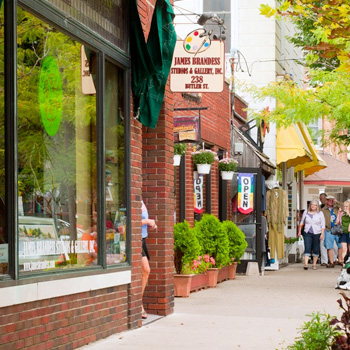10 Local Marketing Ideas for 2020
*Editors Note: We’ve recently updated this blog post for 2020. Read further about updated tech and best local marketing strategies by following the links below:
- Local Marketing 2020 Series: Search Engine Optimization and Local SEO
- Local Marketing 2020 Series: Social Media, Reviews and SEM
- Local Marketing 2020 Series: Email Marketing
- Local Marketing 2020 Series: Print Advertising
The digital revolution has drastically changed the landscape of commerce by exposing even the smallest businesses to a global audience. With relatively minimal effort and investment, virtually any company can sell products and services online to anyone, anywhere, anytime. However, world domination isn’t necessarily everyone’s primary agenda. As awesome as internet marketing may be, it’s often easy for local businesses to feel left out of the excitement. Today, we’ve put together a list of proven local marketing ideas & tactics for all the mom and pop, brick and mortar, main street proprietors out there.
Even if you’re only trying to capture the attention of your neighborhood, community, or city, there is still plenty of opportunity to grow online.

1. Customer Reviews
We are living in a feedback culture. From a consumer standpoint, this is a good thing. Poor service, unfulfilled promises, and sub-par products are brought to the public eye. Companies that take pride in their customer experience, and have the ratings to back it up, are rewarded with more clicks, more calls, more business (and more praise).
Whether someone is searching for a French restaurant or baby boutique, consumer decisions are being made online. A satisfied customer that walks out your door is a wasted opportunity. Encourage patrons to leave a review for your business on Google, Facebook, or Yelp. Don’t be pushy–but don’t be shy either. Instead, subtly suggest the notion while conveying your appreciation. This request can be delivered via point-of-sale signage, receipt verbiage, post-sale email, or by asking the good old-fashioned way.
Of course, not every person will follow through, but you will surely see an uptick in social proof over time. Remember, a happy customer is happy to help!

2. Search Engine Optimization
This isn’t the time nor place for a crash course in SEO. However, this post is the perfect forum to discuss the astounding potential of organic local traffic! The truth is, the small business world is a bit behind on the digital revolution. You still see a good portion of coffee shops and dry cleaners with non-responsive websites, no social media presence, and the list of offenses goes on. Use this to your advantage! You can make a big impact for your business online with relatively low effort and basic search engine optimization practices.
Start with a blog and maybe consider some keyword-rich landing pages as well. Make sure your site adapts to all devices, includes enticing META descriptions, has proper title & heading formats, and plenty of unique, valuable content.

3. Social Media
You may not think a carpet cleaning service needs a Facebook page. Who would follow it and why? Now is the time to cast aside your notions of social media and embrace its local power. First of all, search engines tend to (unofficially) appreciate businesses that are active on Facebook, Twitter, Pinterest, LinkedIn, and Instagram. It never hurts to appease the Google Gods. Secondly, potential customers who are researching your products or services online are likely to stumble upon your social accounts. When they do, are they going to see one lonely post from two Labor Days ago? Or would you rather a vibrant, active feed of fresh content, testimonials, photos, videos, and more?
Once you do start to collect some local followers, social media is a great way to promote offers, specials, announcements, and events! These networks are also great customer service platforms, offering several alternative forms of interaction between you and the local community. Sites like Facebook will continue to change and evolve their algorithm but one truth will always remain: your social media efforts will not go to waste. Get started today. Your audience is waiting!

4. Events
Even in our screen-obsessed society, people still love going out and experiencing things. Granted, it’s usually just so they can post photos of themselves experiencing things, but that’s a conversation for another day. Getting locals through your door to purchase goods and services is ideal, but sometimes needs to be approached in a roundabout way. Consider hosting events, parties, clubs, ceremonies, or meetups at your place of business.
There is major marketing power in events from online promotion to on-site awareness. Amazingly, the nature of the event doesn’t necessarily need to align with your store. In fact, it will help expose your offerings to a whole new group of potential customers. Who says you can’t have a cat enthusiast meeting at a brewery?
Aside from hosting your own, look out for sponsorship opportunities with larger events in your city. Yes, this can be expensive, but there is often great value in aligning your business with a popular entity such as a race or festival. Sponsorships are an effective way to indirectly reach new people while instilling brand recognition (and repetition) in existing customers. The privilege to piggyback on their big-budget event marketing efforts will surely bring some business your way.

5. Email Marketing
In our humble opinion, email marketing is absolutely one of the most effective means of increasing revenue and facilitating growth for virtually all companies of any size in any industry. Yet, small businesses tend to fall short with this opportunity. We’ve all seen the television commercials of the landscaper or interior designer sending their promotional email and bracing for a flood of customer activity. That can (and should) be you!
To run a successful email marketing program, you must look at it in two parts: Collection and Execution. A beautifully-crafted HTML message that is only seen by you and your aunt might as well be a tree falling in the forest. Building your database of subscribers needs to be an ongoing priority. The larger the list, the bigger the result. Always encourage customers to sign up in-store and visitors to join online. Offer incentives for subscribing such as exclusive offers, special event invites, discounts, etc.
Don’t send emails too often or your open rate and unsubscribe rate will suffer. Try to keep your lists segmented by what product or service the individual purchased to ensure future emails are relevant to them. Utilize an email marketing platform such as MailChimp, Constant Contact, or MadMimi for storing your database, sending campaigns, and monitoring results. Be sure to watch your analytics to gain perspective on which emails performed best and what your customers are most interested in.

6. Paid Local Marketing
It almost seems like cheating to advise you to spend money on pay-per-click advertising in a local marketing blog post. The concept may not seem very creative or cost prohibitive–but if done correctly, it certainly can be.
Most of the major PPC platforms such as Google AdWords, Facebook Ads, and Bing Ads allow you to concentrate your campaign on hyper local regions. This means your marketing dollars won’t go to waste on curious clicks from other states (or countries). Additionally, the ability to display ads to individuals with highly specific interests and demographics further increases your chances of making every click count.
Since most search and social ad platforms price clicks and impressions on a bidding system, you will be less likely to compete with big businesses’ national campaigns, thus saving even more money. The best part–no budget is too small. Spend a few bucks a day to put yourself where your customers are looking!

7. In the News
For local businesses, becoming a household name in your community is an ideal scenario. This, of course, isn’t an easy task. It takes time and patience and a bit of luck. However, embracing the power of the press can help you stay relevant and on the minds of your customers. Reporters are always looking for a good fluff story, especially on slow news days. Make it a habit to let local papers, TV stations, blogs, and publications know about your promotions, events, milestones, anniversaries, and accomplishments. Throttle your expectations, of course, as your story won’t always get picked up–but when it does, it’s free publicity. Remember, the only thing better than telling people about your business is someone else telling people about your business!

8. Selective Print Advertising
Old habits die hard. Many established small businesses have placed ads in hometown newspapers, swap sheets, or pennysavers for years. They often continue to do so simply because they always have. However, in the current landscape of local marketing, it’s not the best use of your limited budget. First of all, it is extremely difficult to know how many people saw your ad, were interested in your business, or purchased from you because of the ad. Secondly, why pay for people to see your ad if they don’t care about it? With online advertising, you essentially only pay for potential customers.
Do yourself a favor and conduct an audit of where you’ve spent your marketing dollars in the past and ways you might better use those funds in 2018. Of course, there are always exceptions–print isn’t entirely dead after all. If you’re going to advertise on tv, radio, or in the paper, at least measure the results so you can track your return on investment.

9. Embrace Directories
Many business owners allow their preconceived notions about sites like Yelp, TripAdvisor, and Foursquare prevent them from taking advantage of what they have to offer. Whether it’s a few nasty reviews, unflattering photos, unsolicited feedback, or just a general lack of understanding, your reasons for complacity are not worth the negative impact. We get it, you’re frustrated. You never signed up for this. You magically appeared in their directory one day and now this app can make or break your business. It’s time to adjust your perspective.
These aggregate sites can also be your best friend–if you embrace their local marketing power. Play the game. Claim your listing, update your details, correct your categories, upload some images, double-check your hours and address. If they ask you to pay for a premium service, do it. Your customers are going to these 3rd-party services before (or in lieu of) your own website. Take advantage of what little control you are given and ensure the best representation of your business. Platforms such as Yext and Moz Local provide an efficient means to managing the growing number of directories people use to discover products and service in your city.

10. Cross Promotion
A tried and true method for expanding your reach is to share customers with another local business. Simply forge a relationship with a nearby company that doesn’t compete with yours but instead compliments it. For instance, a steakhouse teaming-up with a theater for a “Dinner and a Movie” promotion or a coffee shop offering a 10% discount to employees of a neighboring business. Get creative and find ways to raise all boats in your area by partnering with those trying to do the same!
As a small business, budget matters and time is your greatest commodity. You don’t have enough of either to spare, so why take chances? Use the proven tips included in this blog post to devise a sensible, yet effective, local marketing strategy for the rest of this year. Be sure to measure your results along the way as you watch your business grow in 2018!

